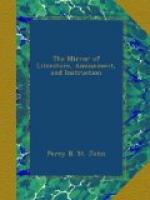Holbein died of the plague in London, 1554.—Westminster Review.
* * * * *
When I see the spirit of liberty in action, I see a strong principle at work; and, this for awhile, is all I can possibly know of it. The wild gas, the fixed air, is plainly broke loose; but we ought to suspend our judgment until the first effervescence is a little subsided, till the liquor is cleared, and until we see something deeper than the agitation of a troubled and frothy surface. I must be tolerably sure, before I venture publicly to congratulate men upon a blessing, that they have really received one.—Burke.
* * * * *
If we must lash one another, let it be with the manly strokes of wit and satire; for I am of the old philosopher’s opinion, that if I must suffer from one or the other, I would rather it should be from the paw of a lion, than from the hoof of an ass.—Addison.
* * * * *
[Illustration: The Central Market, Leeds.]
THE CENTRAL MARKET, LEEDS.
As one of the most elegant and useful buildings of the important town of Leeds, and as characteristic of the public spirit of its inhabitants,[2] the above engraving cannot fail to prove acceptable to our readers; while it may serve as an excitement to similar exertions in other districts.
The Central Market, is erected on the site of the old post-office, at the north-east corner of Duncan-street, the foundation stone of which was laid in 1824. The whole site was excavated, and is divided into cellars, arched and groined, with a spacious area round the whole, for the convenience of access to each, and lighted by powerful convex lenses from the interior of the building. Over these is the principal building—an enclosed market-house, with twenty shops round the exterior for butchers and others, and twenty others corresponding in size with them, fronting the interior. The space within these, on the ground floor, is fitted up with twenty single stands for fruit and vegetables. Three sides of the square form a spacious gallery, commodiously fitted up with thirty-six stands of convenient dimensions, as a Bazaar. The interior is lighted and ventilated by three rows of windows, one row on the Bazaar floor, and two rows in the roof. The roof, the carpentry of which has been pronounced a master-piece, is supported by twelve cast-iron columns and sixteen oak pillars, and is 34 ft. 6 in. high; the height from the floor to the upper point of the ceiling being 54 ft. 4 in. The size within the walls is 138 ft. by 103 ft. The principal entrance is at the south front from Duncan-street, on each side of which are three large shops fronting the street, with a suite of six offices above. Over this entrance is an entablature richly embellished with fine masonry, and supported with




